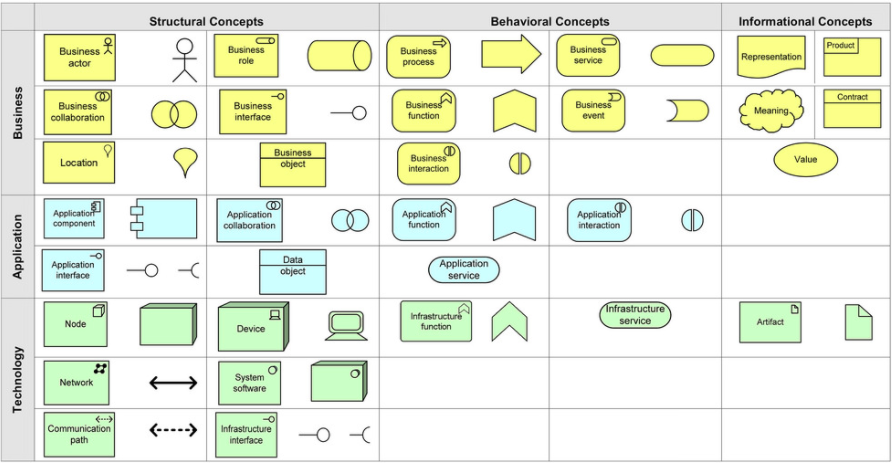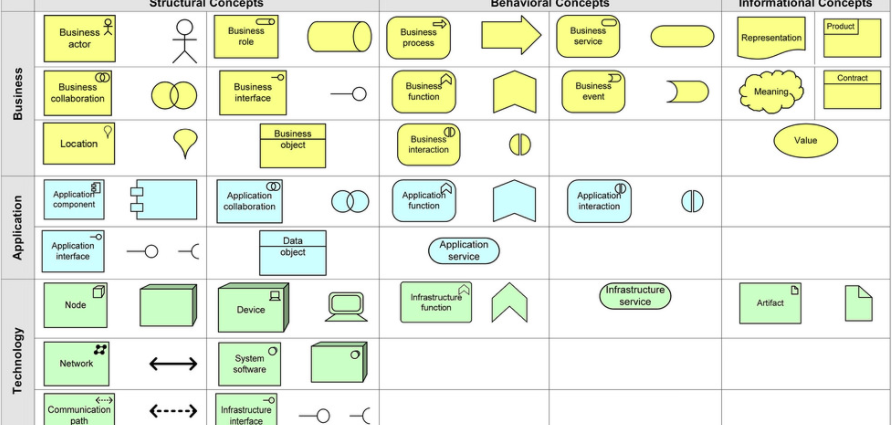ArchiMate is a powerful enterprise architecture modeling language that helps organizations visualize, analyze, and optimize their architectures. To effectively use ArchiMate, it’s crucial to understand its two fundamental concepts: layers and aspects. This tutorial will guide you through these key concepts, explaining their distinctions and relationships, and how they work together to create comprehensive enterprise architecture models.
1. Introduction to ArchiMate
ArchiMate is an open and independent enterprise architecture modeling language that supports the description, analysis, and visualization of architecture within and across business domains. It provides a standardized way to represent the various components of an enterprise architecture and their relationships.
2. Understanding Layers
ArchiMate defines three primary layers, each representing a different dimension of an enterprise architecture. These layers help to organize and structure the architecture models.

Business Layer
The Business Layer focuses on the business services provided to customers. It includes:
- Business Processes: The activities and workflows that achieve specific business goals.
- Business Actors: The people, roles, or organizational units that perform these processes.
- Business Functions: The capabilities or functions that the business performs.
- Business Interactions: The communications and collaborations between business actors.
Example: In a retail company, the Business Layer would model processes like order processing, customer service, and inventory management, along with the actors involved, such as sales representatives and customers.
Application Layer
The Application Layer depicts the software applications that support the business processes. It includes:
- Application Services: The services provided by applications to the business layer.
- Application Components: The software components that make up the applications.
- Application Interactions: The communications between application components.
Example: For the same retail company, the Application Layer would model the CRM system, inventory management software, and the interactions between these applications.
Technology Layer
The Technology Layer represents the underlying technology infrastructure. It includes:
- Technology Services: The services provided by the technology infrastructure, such as data storage and network services.
- Technology Components: The hardware and software components that make up the infrastructure.
- Technology Interactions: The communications between technology components.
Example: In the retail scenario, the Technology Layer would model the servers, databases, and network devices that support the CRM system and inventory management software.
3. Understanding Aspects
In addition to layers, ArchiMate defines three aspects that categorize the types of elements within each layer. These aspects help to classify the elements based on their roles and behaviors.

Active Structure Aspect
The Active Structure Aspect represents structural entities that exhibit behavior. These include:
- Business Actors: People or roles that perform business processes.
- Application Components: Software components that provide application services.
- Technology Nodes: Hardware or software components that provide technology services.
Example: In the retail company, active structure elements could include sales representatives (Business Layer), the CRM system (Application Layer), and servers (Technology Layer).
Behavior Aspect
The Behavior Aspect focuses on the behaviors performed by active structure elements. These include:
- Business Processes: The activities performed by business actors.
- Application Functions: The functions performed by application components.
- Technology Functions: The functions performed by technology components.
Example: Behavior elements could include the order processing workflow (Business Layer), the customer data management function (Application Layer), and the data storage function (Technology Layer).
Passive Structure (information) Aspect
The Passive Structure Aspect captures objects that are acted upon or utilized by active structures. These include:
- Business Objects: Information entities used in business processes.
- Data Objects: Information entities used in application functions.
- Artifacts: Physical or digital objects used in technology functions.
Example: Passive structure elements could include customer orders (Business Layer), customer data records (Application Layer), and database files (Technology Layer).
4. Integration of Layers and Aspects
The relationship between layers and aspects creates a comprehensive framework for enterprise architecture modeling. Each layer can contain elements from all three aspects, allowing architects to depict complex interactions and dependencies within their models.
Example Scenario
Consider a retail company’s order processing system:
- Business Layer: A business service (e.g., order fulfillment) is provided to customers. This service is realized through business processes (e.g., order processing) performed by business actors (e.g., sales representatives).
- Application Layer: The order processing business process is supported by an application service (e.g., order management service) provided by an application component (e.g., CRM system).
- Technology Layer: The CRM system is supported by technology services (e.g., data storage service) provided by technology components (e.g., servers and databases).
Visualization
The interplay among these layers can be visualized through various diagrams:
- Business Process Diagram: Shows the order processing workflow and the interactions between business actors.
- Application Component Diagram: Shows the CRM system and its interactions with other application components.
- Technology Infrastructure Diagram: Shows the servers, databases, and their interactions.
5. Practical Examples
Example 1: E-commerce Platform
-
Business Layer:
- Business Actors: Customers, Sales Representatives
- Business Processes: Order Placement, Payment Processing
- Business Objects: Customer Orders, Invoices
-
Application Layer:
- Application Components: E-commerce Platform, Payment Gateway
- Application Functions: Order Management, Payment Processing
- Data Objects: Customer Data, Order Data
-
Technology Layer:
- Technology Components: Web Servers, Databases
- Technology Functions: Data Storage, Network Services
- Artifacts: Database Files, Configuration Files
Example 2: Healthcare System
-
Business Layer:
- Business Actors: Doctors, Patients
- Business Processes: Patient Registration, Appointment Scheduling
- Business Objects: Patient Records, Appointment Schedules
-
Application Layer:
- Application Components: Electronic Health Record (EHR) System, Scheduling Software
- Application Functions: Patient Data Management, Appointment Management
- Data Objects: Patient Data, Appointment Data
-
Technology Layer:
- Technology Components: Servers, Databases
- Technology Functions: Data Storage, Network Services
- Artifacts: Database Files, Backup Files
6. Conclusion
Understanding the distinction between layers and aspects in ArchiMate is essential for effective enterprise architecture modeling. Layers provide a structural hierarchy representing different dimensions of an organization, while aspects categorize the types of elements within those layers. Together, they enable architects to create detailed models that facilitate communication and analysis across various stakeholder concerns.
By mastering these key concepts, you can leverage ArchiMate to design and optimize your enterprise architecture, ensuring alignment between business goals, application capabilities, and technology infrastructure.
